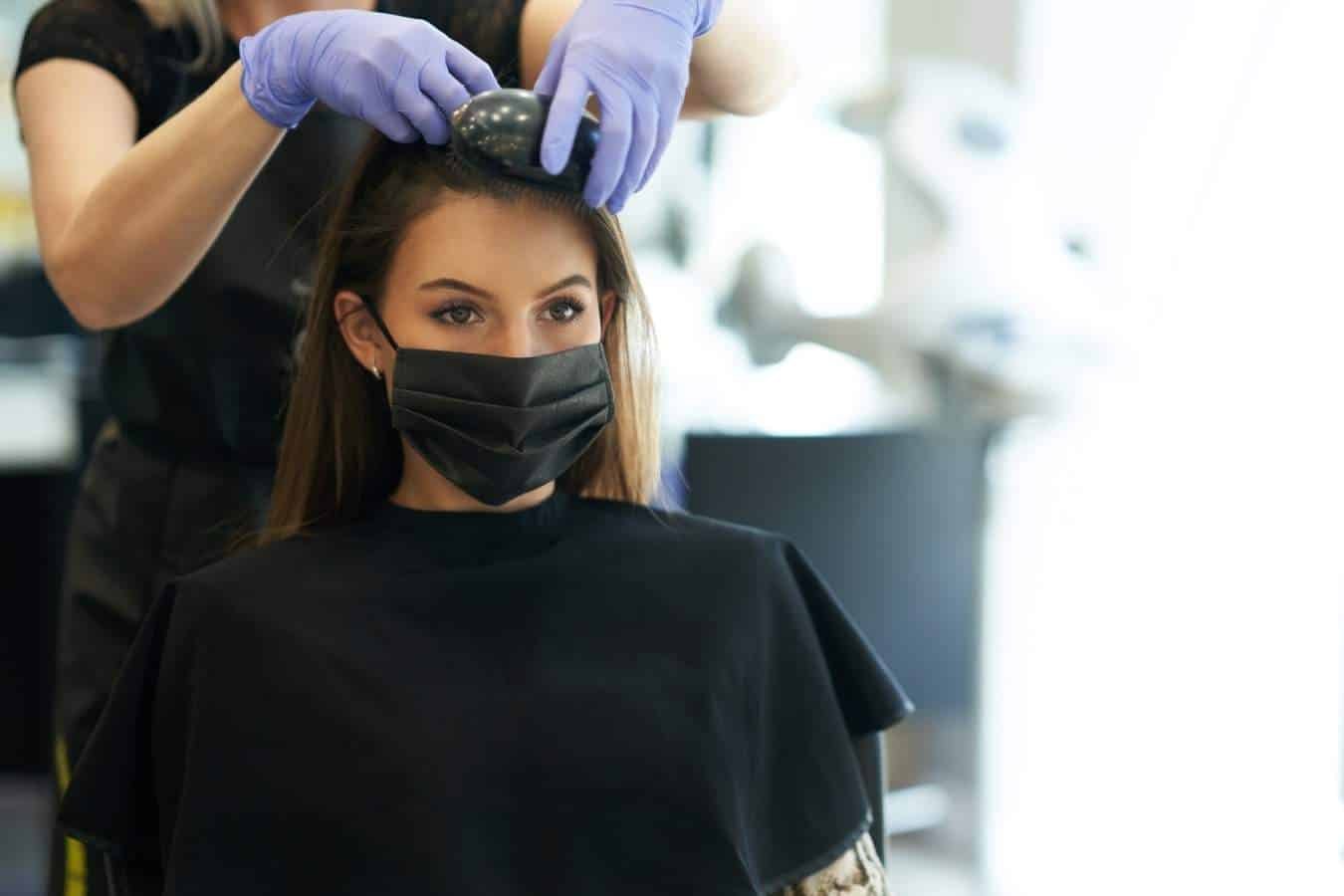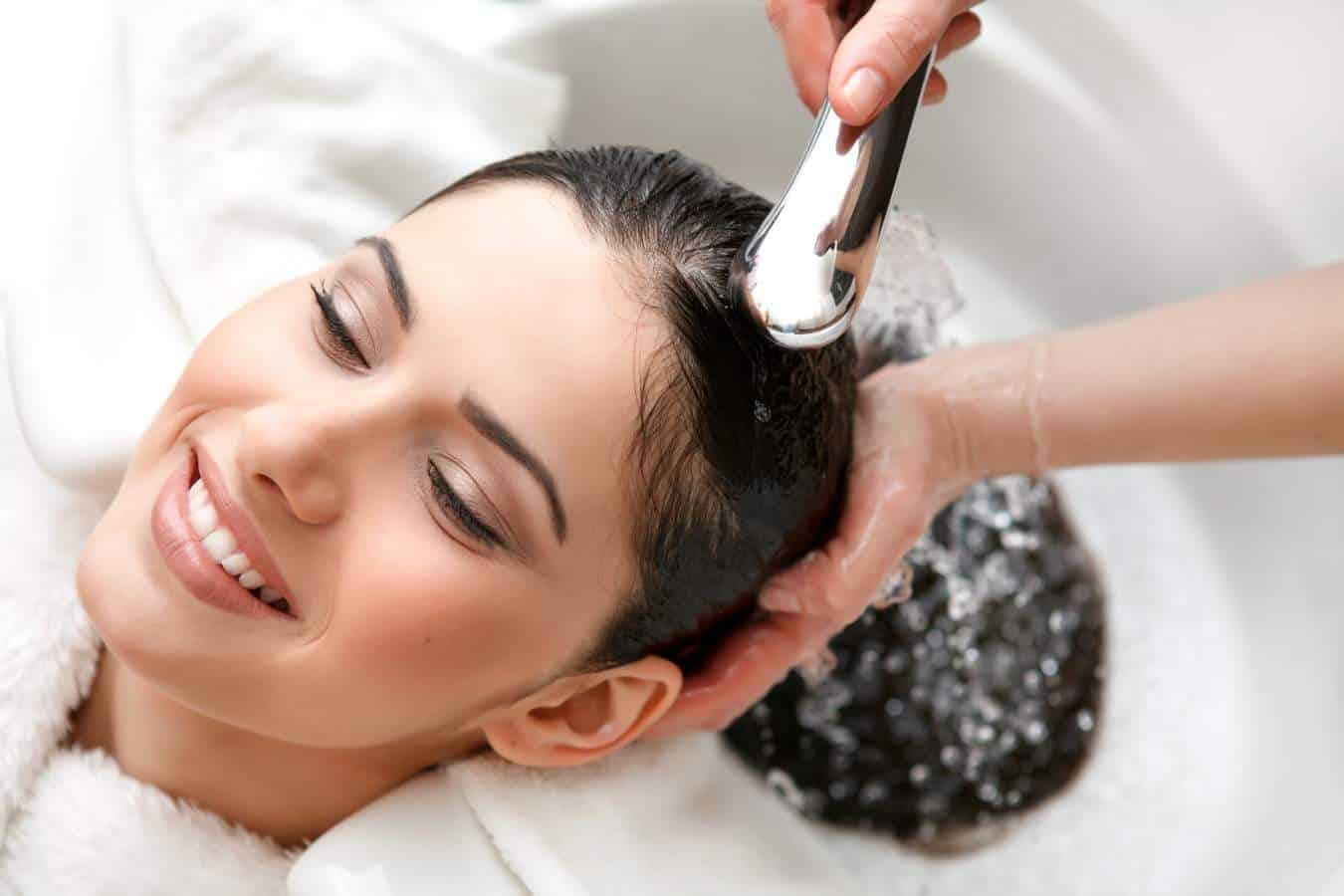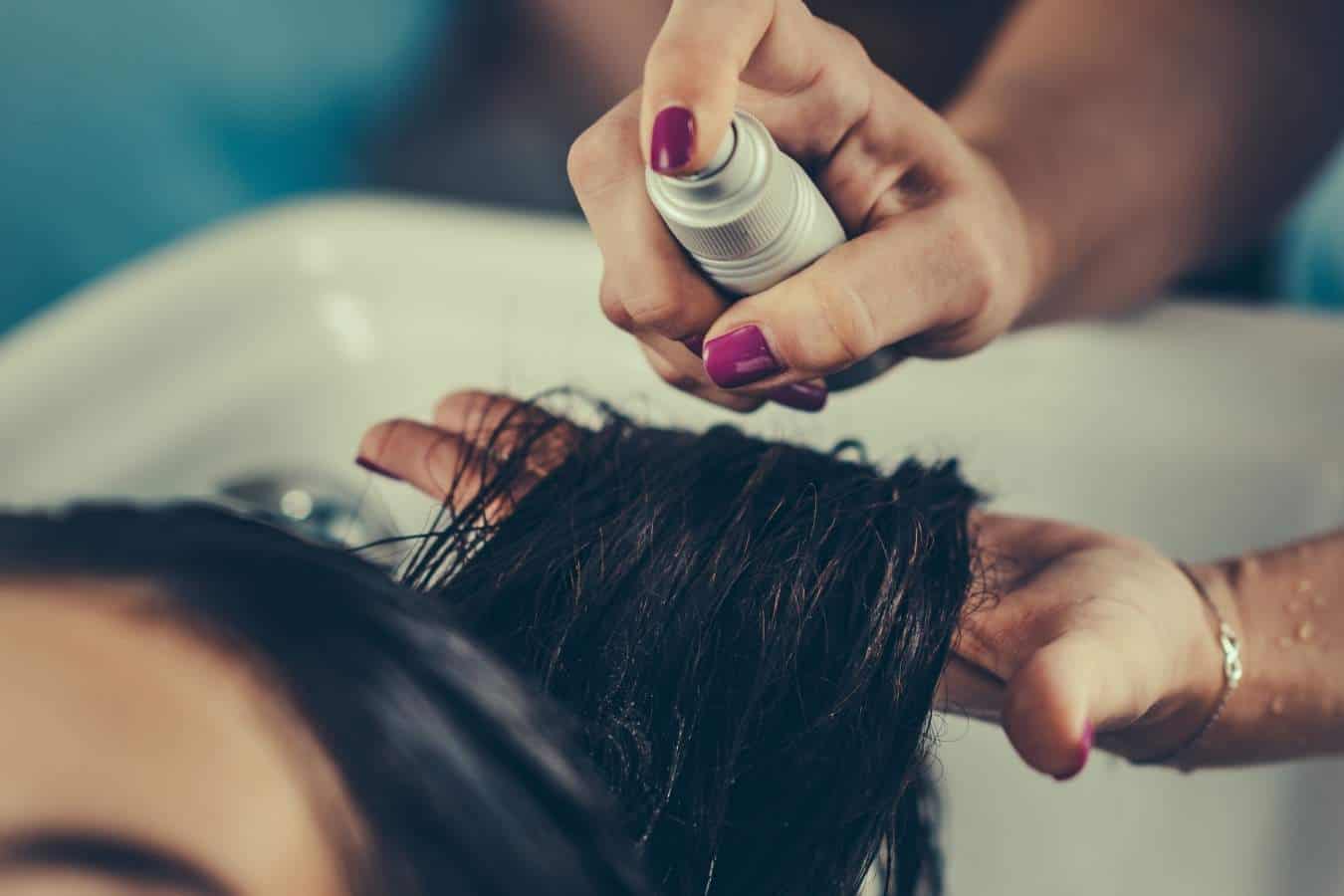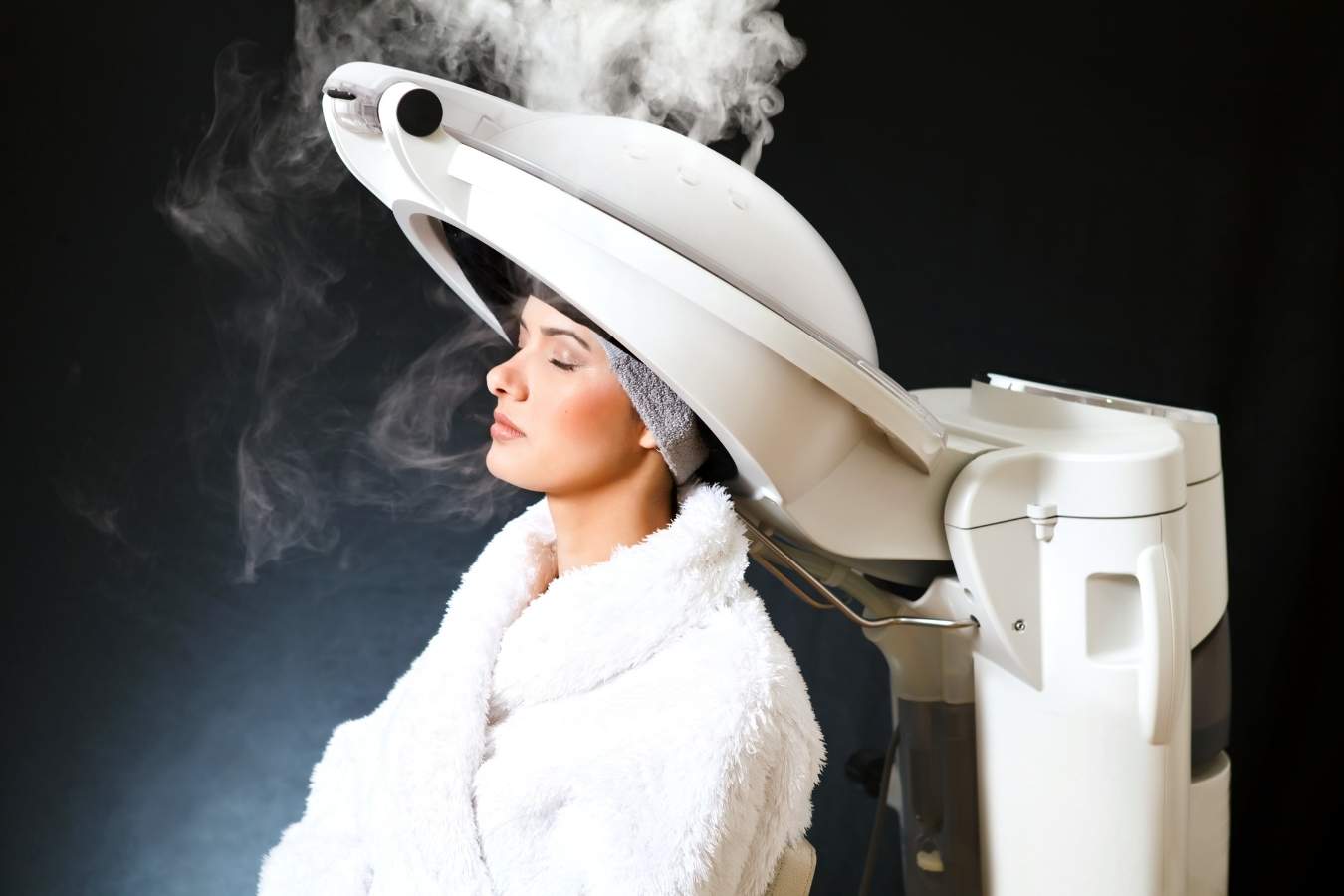You can have smoother and straighter hair without resorting to damaging chemicals. Read on to discover what type of non-toxic hair smoothing treatment works best for you.

Most hair smoothing treatments use a formaldehyde-based formula that can cause adverse health effects. Non-toxic hair smoothing treatments are a better alternative if you want straighter and sleeker without using damaging chemicals. They involve gentler and safer ingredients that are still effective at making hair frizz-free and more manageable.
This post contains affiliate links and we may earn if you click on them (at no extra cost to you). Please read our full disclosure policy here.
What Is A Hair Smoothing Treatment?
A hair smoothing treatment alters the structure of curly and frizzy hair and transforms it into a smoother and sleeker shape.
How does this happen? Human hair is mainly made from a fibrous protein called keratin, which is, in turn, made from amino acids.
The keratin in your hair strands is held together by two types of bonds 一 hydrogen and disulfide bonds.
Both bonds determine the shape of the hair, but hydrogen bonds are weaker, temporary, and can be easily changed.
Disulfide bonds are stronger and occur between cysteine amino acids. The cysteine amino acids form bonds with other cysteine amino acids further down the hair shaft, pulling hair into a wave or curl.
The curliness of hair increases if there are more disulfide bonds between hair proteins.
Therefore, hair smoothening involves breaking the disulfide bonds of the hair shaft.
The bonds are restructured by applying heat and sealed with chemicals, so the hair maintains its new shape for longer.
Difference Between Hair Smoothing And Hair Straightening

The main difference between hair smoothing and hair straightening is that smoothing won’t make your hair super straight, and it doesn’t last as long.
Hair smoothening doesn’t alter the structure of the hair drastically and is designed to reduce frizz.
On the other hand, hair straightening can deliver poker-straight strands but causes more damage.
Hair straightening can be temporary if you use heat-styling tools like hot irons and combs. However, it’s permanent if you use chemical processes that break the disulfide bonds.
The 5 Best Non-Toxic Hair Smoothing Treatments
Natural Formula Keratin-Infused Anti-Frizz Moisturizing Hair Mask. The product also includes keratin hair serum for a smoother result. It promises to help you maintain hair straightening results 3 times longer.
Peter Coppola a-Keratin Express Smoothing Kit. The kit comes with a clarifying shampoo for cleansing hair before applying the keratin treatment. Whether you have curly or straight hair, you can achieve smooth, frizz-free healthy hair.
John Frieda Frizz Ease 3-day Flat Iron Spray. If you have frizzy, curly, and unmanageable hair, this product can give your locks a silky smooth finish. Results last up to 3 days or until your next wash.
GK Smoothing Keratin Hair Treatment. This Brazilian Keratin treatment smoothes and strengthens for a freeze-free effect that lasts between 3 and 5 months. As with most non-toxic hair smoothing treatments, there is no wait time after application, so you can immediately wash your hair.
Suave Professionals Smoothing Keratin Infusion. This shampoo and conditioner combo helps to combat frizz for up to 48 hours. It leaves hair shiny, smooth, and easy to style.
Types Of Hair Smoothing Treatments
Here’s a look at the common types of hair smoothing treatments used to treat unruly, frizzy, knotted, and unmanageable hair:
Blow Drying and Flat Ironing
Using a blow dryer, flat iron, or straightening brush is an easy at-home smoothing treatment.
This non-chemical process relies on heat to break the bonds in hair, allowing the hair to straighten.
The bonds are reformed in different positions when the hair cools down, so the hair stays straight.
However, the change in the hair structure is temporary.
Keratin Treatments
Keratin treatments, aka Brazilian blowout/straightening, involve the application of a keratin solution that breaks down the bonds in the hair.
A flat iron is then used to further straighten the hair and effectively seal the formula. Keratin treatments are ideal because keratin is a protein naturally found in hair.
Coating the hair shaft with keratin creates a moisture barrier that strengthens the hair, eliminates frizz, and gives a smooth, shiny finish.
Hot Oil Treatments
Hot oil treatment is a natural DIY (albeit short-term) way of achieving smooth, silky-soft hair.
You can use common oils like coconut oil, olive oil, avocado oil, and jojoba oil. Simply heat the oil and apply it from the scalp to the tips.
The hot oil will coat and penetrate the hair shaft, moisturizing, nourishing, and smoothening your hair strands.
This results in stronger and shinier hair that’s more manageable.
Hair Relaxing
Hair relaxing typically uses lye-based formulations that contain sodium hydroxide as the main ingredient.
Sodium hydroxide is alkaline and has a high pH level that’s strong enough to change the hair structure.
There are also no-lye relaxers for sensitive scalps. These are milder because they contain calcium hydroxide or guanidine hydroxide with a lower pH. Hair relaxing is mostly used to soften tight curls.
While it makes the hair smooth, additional straightening treatments may be necessary.
Hair Rebonding or Thermal Reconditioning
Hair rebonding or thermal conditioning is also known as Japanese straightening.
The treatment is similar to hair relaxing because it uses chemicals that change hair structure. However, hair rebonding also involves heating the hair to make the hair straighter.
A flat iron is used to style the hair, and a neutralizer is then applied to lock the hair into its new shape.
Toxic vs. Non-Toxic Hair Smoothening Treatments

Some methods used to achieve smoother and straighter hair can lead to unwanted side effects, such as dry, brittle hair and hair loss.
For example, hair smoothening treatments like heat styling and chemical straightening strip the hair of its natural oils over time.
It also breaks the bonds in your hair, altering and weakening its structure.
Overall, this leads to dryness, dullness, split ends, breakage, and poor hair growth.
However, some hair smoothening treatments not only cause hair damage, but they can be downright toxic.
Take, for instance, traditional keratin treatments. As mentioned, a keratin treatment smoothes and straightens hair by adding keratin, a natural protein found in your hair.
The keratin usually contains a formaldehyde chemical to make the straightening solution more effective. But formaldehyde also increases the risk of cancer.
In addition, the formaldehyde vapors that are released when heat is applied also cause eye irritation, coughing, wheezing, dizziness, and headaches, plus other nasty side effects.
While traditional keratin treatments are popular because the formaldehyde helps deliver a false, shiny finish, they create dry and brittle hair in the long run.
In contrast, non-toxic hair smoothing differs from toxic hair smoothing treatments in the following ways:
No formaldehyde
Non-toxic hair smoothing treatments are not formaldehyde-based and don’t contain formaldehyde donors.
The lack of toxic chemicals makes these treatments much safer.
They don’t make the eyes watery, irritate the skin, or pose a significant health risk.
More flexibility
It’s possible to use different formulations, processing times, and heat levels to achieve different results based on the desired level of smoothness and straightness.
So your hair can look as straight as a pin, or you can keep your wave or curl while getting rid of the frizz.
Gentle ingredients
The treatment won’t dry your hair and often contains natural ingredients. Some non-toxic hair smoothing treatments are even vegan and cruelty-free.
Hair can be washed sooner
Non-toxic hair treatments enable amino acids to penetrate the deeper layers of the hair shaft. The amino acids are sealed in and nourish hair from the inside.
This is different from toxic treatments that create a false, shiny coat that isn’t supposed to be washed off immediately.
Costs more
While a non-toxic hair smoothing treatment offers many advantages, it typically costs more than a traditional smoothing treatment.
How Does a Non Toxic Hair Smoothing Treatment Work?

A non-toxic hair smoothing treatment infuses the hair shaft with amino acids.
For instance, cysteine hair treatment uses cysteine, a naturally occurring amino acid, to smoothen and straighten hair.
The procedure looks something like this:
- Shampoo and dry hair. Wash using a clarifying shampoo and blowdry the hair. Cleaning your hair first makes it easier to achieve the desired results.
- Apply the product. Apply the product to small sections of hair, then let it sit. This gives the cuticle more time to open, allowing the amino acids to enter the hair. Sometimes heat is applied (blow drying and ironing) to make the treatment more effective.
- Rinse thoroughly. Rinse the product and blow dry to reveal shinier, smoother, and straighter hair.
How Long Does A Hair Smoothing Treatment Last?
Hair smoothing treatment can last anywhere from several weeks to 6 months or more. A proper hair care regime is the secret to a longer-lasting hair smoothing treatment. The following tips can help:
- Avoid products with sulfates. Sulfates lift the hair cuticle, so the treatment washes away easily.
- Avoid products with keratin. They lead to protein overload, which dries out hair.
- Don’t wash your hair excessively or swim in chlorinated or saltwater. This strips the treatment away faster.
Disclaimer: This site is not intended to provide professional or medical advice. All of the content on LovedByCurls.com is for informational purposes only. All advice should be followed at your own discretion. Ingredients may change at any time so always check the product label before using. Check our full disclaimer policy here.
